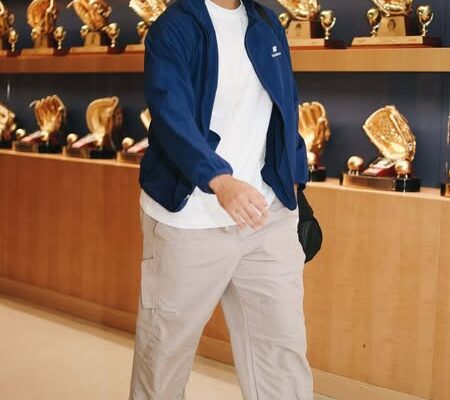Shohei Ohtani: The Two-Way Superstar Transforming Baseball’s Limits
Shohei Ohtani is a name that has become synonymous with unprecedented talent and baseball history in the making. Born on July 5, 1994, in Oshu, Iwate Prefecture, Japan, Ohtani has shattered conventional boundaries in professional baseball as a two-way player—excelling both as a pitcher and a hitter at the highest level. His journey from a prodigious young talent in Japan to a transformative figure in Major League Baseball (MLB) reflects not only his extraordinary skills but also a new era of what’s possible in the sport.
This article explores Ohtani’s rise, his unique blend of skills, the impact he has on baseball’s culture and strategy, and why he is inspiring a new generation of athletes around the world.
Shohei Ohtani’s passion for baseball started early. Growing up in Japan, he was a standout in both pitching and hitting throughout his high school years. His talent was evident at Hanamaki Higashi High School, where scouts and fans alike marveled at his ability to dominate games on both sides of the ball.
Unlike many players who specialize early, Ohtani’s coaches encouraged his two-way abilities. He consistently threw fastballs clocked in the high 90s mph range (a rarity in Japan) and hit with remarkable power. This dual skill set set him apart from the outset.
After graduating high school, Ohtani bypassed college to join the Hokkaido Nippon-Ham Fighters of Nippon Professional Baseball (NPB) in 2013. The Fighters recognized his unique potential and gave him the rare chance to develop as both a pitcher and hitter in the professional league. Over the next five seasons, Ohtani would stun fans and experts alike with his exceptional performance.
During his time in NPB, Ohtani’s two-way abilities flourished. As a pitcher, he reached triple-digit velocities, throwing fastballs at 100 mph (162 km/h) or more—an extraordinary feat in Japan’s more contact-oriented league. His splitter and slider complemented his fastball, making him an intimidating presence on the mound.
At the plate, Ohtani showcased power and discipline. He consistently posted batting averages around .300, with home runs and slugging percentages rivaling the best hitters in the league. His combination of speed, power, and plate discipline made him a true five-tool player.
One of the most impressive aspects of Ohtani’s NPB career was his ability to handle the physical demands of pitching and hitting regularly—something that had become rare in modern baseball, even in Japan. His training regimen and natural durability allowed him to contribute on both fronts, a rarity that drew increasing international attention.
In 2017, Shohei Ohtani declared his intention to join MLB, drawing interest from teams around the league. His decision sparked a wave of excitement and curiosity. Could a player succeed at the highest level as a two-way star?
Ohtani ultimately signed with the Los Angeles Angels in December 2017. The Angels made a bold commitment to accommodate his unique talents, promising to let him pitch and hit—a commitment that other teams had been hesitant to make given the risks and challenges involved.
Ohtani’s rookie season in MLB in 2018 was nothing short of sensational. He quickly proved that he belonged among the game’s elite.
On the mound, he pitched with blazing velocity, touching 101 mph, and demonstrated a maturity beyond his years with his breaking balls and command. Despite some innings limits imposed to protect his arm, he posted a respectable 3.31 ERA and struck out 63 batters in 51.2 innings.
At the plate, Ohtani’s power translated immediately to MLB pitching. He hit 22 home runs, drove in 61 runs, and stole 10 bases while batting .285—a remarkable output for any player, let alone one who also pitched.
Ohtani’s rookie campaign earned him the American League Rookie of the Year award, and more importantly, it captivated fans worldwide. For the first time in decades, fans witnessed a true two-way player succeed in the modern MLB era.
Ohtani’s story is also one of perseverance. After his explosive rookie season, he faced setbacks. Injuries forced him to focus primarily on hitting during the 2019 and 2020 seasons. He underwent Tommy John surgery on his pitching elbow, which sidelined him from throwing for a significant period.
Many wondered whether he could return to pitching at the elite level that fans had seen in 2018. The surgery, rehabilitation, and mental challenges posed a daunting test for Ohtani.
The 2021 MLB season was a watershed moment for Ohtani and baseball history. He returned to pitching after a two-year hiatus and simultaneously dominated at the plate like never before.
Ohtani’s stats from the 2021 season are historic:
- As a hitter, he smashed 46 home runs, drove in 100 runs, and stole 26 bases while hitting .257.
- As a pitcher, he posted a 3.18 ERA, struck out 156 batters in 130 innings, and became one of the league’s most exciting starters.
He was named an All-Star both as a pitcher and designated hitter—the first player ever to achieve that distinction. Ohtani’s electrifying performances earned him the American League Most Valuable Player (MVP) award, recognizing him as the best player in the league.
Shohei Ohtani’s success challenges the long-held notion that players must specialize in one role to succeed at the highest level. In an era where specialization and workload management dominate, Ohtani embodies a return to the baseball ideal of versatility and all-around excellence.
His ability to pitch at over 100 mph and then hit towering home runs in the same game defies conventional wisdom. His skill set forces teams, coaches, and analysts to reconsider how players are developed and utilized.
Ohtani’s impact extends beyond statistics and records. He has become a global ambassador for baseball, bridging Japan and the United States with his charisma, humility, and outstanding talent. He inspires young players worldwide to pursue their dreams without limits.
His presence has also boosted MLB’s international appeal, drawing millions of new fans—especially in Asia—who follow his every move with passion.
Fans admire not only his on-field exploits but also his professionalism and sportsmanship. Ohtani’s quiet confidence and dedication make him a role model for athletes across sports.
At just 30 years old in 2025, Shohei Ohtani’s best years may still be ahead. If he can maintain his health, his impact on baseball could last for a decade or more.
The challenge remains to balance the physical demands of pitching and hitting to sustain elite performance. The Angels and Ohtani’s trainers are pioneers in managing his workload, blending cutting-edge sports science with his natural durability.
Beyond his playing career, Ohtani’s legacy could influence how baseball is played and coached for generations. Young athletes who might have previously been pushed to specialize may find encouragement in his example to embrace multiple skills.
Shohei Ohtani is much more than a baseball player; he is a phenomenon pushing the limits of what the sport thought possible. As a two-way star, he has redefined excellence by mastering pitching and hitting at the highest level in the most competitive league in the world.
His journey from Japan to MLB, overcoming injuries, and inspiring millions is a testament to talent, hard work, and the power of dreams. Baseball’s landscape has changed because of Ohtani, and his story continues to unfold—captivating fans and rewriting the rules for future generations.
In an age when sports often encourage narrow specialization, Ohtani stands tall as a beacon of versatility and greatness, proving that true legends can excel in more than one way. The world of baseball is richer, more thrilling, and more inclusive thanks to Shohei Ohtani, the two-way superstar who keeps pushing baseball’s limits.
If you want, I can also provide a more detailed breakdown of his stats, key moments, or comparisons to historic two-way players like Babe Ruth! Just let me know.



